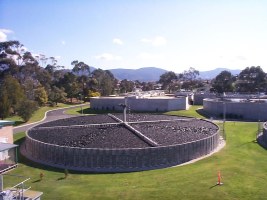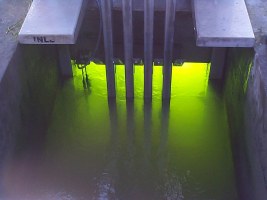Nutrient-rich effluents are discharged in waterways from various point- and non-point sources within catchments.
The number of nutrient point sources per unit catchment area in Australia’s Intensive Landuse Zone was used as an indicator of ‘nutrient point source hazard’ during the National Land and Water Resources Audit, in the assessment catchment condition 1. The point sources were extracted from the Australian Rivers and Catchment Condition Database (formerly Wild Rivers 2 3) and included quarries, mines and chemical plants (i.e. industrial point sources), and dairy’s, abattoirs, livestock production and sewage treatment works (i.e. urban and agricultural point sources). Another point source of nutrients attracting recent attention is caravan parks without sewers.


Photo 1. (a) The Macquarie Point wastewater treatment plant; and (b) UV treatment for effluent re-use (photos by Brendan Hanigan, Hobart City Council and used with the permission of Tasmanian Department of Environment)
Coastal issues arising from point sources of nutrients
Some potential impacts on coastal environments caused by industrial point sources are:
- eutrophication, potentially leading to algal blooms, anoxic & hypoxic events; and fish kills;
- degradation of coastal habitats; and
- declines in fish stocks and biodiversity.
Existing information and data
More information and maps showing ‘nutrient point source hazard’ can be found at the Catchment Condition Online Maps website 4. Appendix I (pp. 311-312) in Volume 2 of the Australian Catchment, River and Estuary Assessment, 2002 contains a map of Australia’s River Basins and Drainage Divisions in which each river basin has been assigned a number. These catchment numbers can be matched to a large number of coastal waterways in pages 316-363 of the same document. The nutrient point source hazard scores for a large number of river basins are available in Appendix B (pg 65-76) of the Assessment of Catchment Condition in Australia’s Intensive Land Use Zone: A biophysical assessment at the national scale 1. Point source nutrient loads are a parameter in the Simple Estuarine Response Model developed by CSIRO.
- The assessment of catchment condition was conducted as a partnership between the Audit, the Bureau of Rural Sciences and CSIRO Land and Water with support and involvement of State and Territory natural resource management agencies. The final report (Project 7/8) to the National Land and Water Resources Audit by Walker, J., Veitch, S. Braaten, R., Dowling, T., Guppy, L., Herron, N (2001) is entitled Assessment of Catchment Condition in Australia’s Intensive Land Use Zone: A biophysical assessment at the national scale and is found at the following website Assessment of catchment condition in Australia’s intensive land use zone : a biophysical assessment at the national scale / Joe Walker, Simon Veitch. ↩ ↩
- Stein, J.L., Stein, J.A. and H. Nix. 2001. Wild Rivers in Australia. International Journal of Wilderness 7(1), 20-24. ↩
- Stein, J.L., Stein, J.A. and H. Nix. 2001. The identification of Wild rivers: Methodology and Database Development. (https://trove.nla.gov.au/work/35356267?selectedversion=NBD21532280 ↩
- Catchment Condition Online Maps website at Agriculture, Fisheries & Forestry Australia. ↩


